
S&P 500
Upwards movement overall was expected for the week, which is what has happened.
Summary: For the short term, another upwards wave to 2,835 may begin on Monday. After that some sideways movement or a deeper pullback may begin.
Overall, this bounce is expected to be incomplete. It may continue for another one to few weeks and may end somewhere between 2,873.54 to 2,890.38.
The larger picture still expects a primary degree fourth wave is unfolding, which may continue for another few weeks. It is still impossible to tell which of many Elliott wave structures it may be, so flexibility for short-term expectations is essential.
The biggest picture, Grand Super Cycle analysis, is here.
Last published monthly chart is here, video is here.
ELLIOTT WAVE COUNT
WEEKLY CHART
Cycle wave V must complete as a five structure, which should look clear at the weekly chart level and also now at the monthly chart level. It may only be an impulse or ending diagonal. It is clear it is an impulse.
Cycle wave V has passed equality in length with cycle wave I, and 1.618 the length of cycle wave I. The next Fibonacci ratio is used to calculate a target. When primary wave 4 is complete and the starting point for primary wave 5 is known, then the final target may also be calculated at primary degree. At that stage, there may be two targets, or the final target may widen to a small zone.
Within cycle wave V, the third waves at all degrees may only subdivide as impulses.
Within primary wave 3, there is perfect alternation and excellent proportion between intermediate waves (2) and (4).
The maroon channel is drawn about primary degree waves. The first trend line is drawn from the ends of primary waves 1 to 3, then a parallel copy is placed upon the low of primary wave 2. The overshoot of the upper edge of this channel by the end of intermediate wave (3) looks typical. For the S&P, its third waves are usually the strongest portion of an impulse; they often exhibit enough strength to overshoot channels.
Primary wave 4 now has an overshoot on the lower edge of the channel. This is acceptable; fourth waves are not always neatly contained within channels drawn using this technique.
Primary wave 4 may find very strong support about the lower edge of the teal channel, and it looks like this is from where price may be bouncing. This channel is copied over from the monthly chart and contains the entire bull market since its beginning in March 2009. While Super Cycle wave (V) is incomplete, this channel should not be breached at the weekly chart level.
Primary wave 4 may not move into primary wave 1 price territory below 2,111.05.
At this stage, the expectation is for the final target to be met in October 2019. If price gets up to this target and either the structure is incomplete or price keeps rising through it, then a new higher target would be calculated.
DAILY CHART
Primary wave 4 would most likely end somewhere within the price territory of the fourth wave of one lesser degree. Intermediate wave (4) has its price territory from 2,872.87 to 2,532.69. Within this range sit the 0.236 Fibonacci ratio at 2,717 and the 0.382 Fibonacci ratio at 2,578.
The 0.382 Fibonacci ratio would expect an overshoot of the teal channel. This may be too low; price may find support at the lower edge of the channel. However, as primary wave 4 should be expected to exhibit reasonable strength, it may be able to overshoot the channel and that would look reasonable. This possibility is now more seriously considered.
Primary wave 2 unfolded as a shallow regular flat correction lasting 10 weeks.
Intermediate wave (A) may be seen as a complete zigzag. A zigzag down to start primary wave 4 may also be labelled intermediate wave (W).
If intermediate wave (A) or (W) subdivide as a zigzag, then primary wave 4 may unfold as a double zigzag, double combination, flat or triangle. Of all these possible structures a flat correction would be least likely as that would not offer structural alternation with the flat correction of primary wave 2.
A double zigzag will be considered below in a second alternate wave count.
A triangle would be fairly likely even though intermediate wave (4) was a triangle. This does not reduce the probability of primary wave 4 also subdividing as a triangle.
A double combination should always be considered if a triangle is possible, and this would also offer reasonable alternation with primary wave 2.
A triangle, combination or flat would all expect a high bounce for intermediate wave (B) or (X). Intermediate wave (B) or (X) would most likely subdivide as a zigzag.
Within a triangle for primary wave 4, intermediate wave (B) would most likely be about 0.8 to 0.85 the length of intermediate wave (A) giving a target range from 2,873.54 to 2,890.38. Intermediate wave (B) of a running triangle may make a new high above the start of intermediate wave (A). The target calculated would see intermediate wave (B) about 0.74 the length of intermediate wave (A); although this would be a little shorter than the most common length, it would still be acceptable.
Within a double combination for primary wave 4, intermediate wave (W) may be the first complete structure in a double. Intermediate wave (X) may be a very high bounce and may make a new high above the start of intermediate wave (W). There is no minimum requirement for the length of intermediate wave (X), and no maximum limit. The target calculated for intermediate wave (X) would see it as a reasonably high bounce; this would give a combination the right look.
When intermediate wave (B) or (X) is complete, then intermediate wave (C) or (Y) downwards may complete primary wave 4. If primary wave 4 is a triangle, then intermediate waves (C), (D) and (E) would be required to complete it.
For both of the more likely options of a triangle or combination for primary wave 4, price may continue to find support about the lower edge of the teal trend channel. This would give the wave count the right look at the monthly time frame.
ALTERNATE WAVE COUNT
DAILY CHART
It is also possible to see the downwards wave labelled intermediate wave (A) as a complete impulse. If intermediate wave (A) is a five wave structure, then intermediate wave (B) may not move beyond its start above 2,940.91.
Primary wave 4 may be a zigzag to provide structural alternation with the flat correction of primary wave 2; intermediate wave (A) within a zigzag must subdivide as a five wave structure. When intermediate waves (A) and (B) are complete, then intermediate wave (C) would most likely end below the end of intermediate wave (A) to avoid a truncation. This would see the end of primary wave 4 substantially overshoot the lower edge of the teal channel, which would be unlikely and is why this alternate wave count is judged to have a lower probability than the main wave count.
Primary wave 4 may not move into primary wave 1 price territory below 2,111.05.
SECOND ALTERNATE WAVE COUNT
DAILY CHART
This second alternate wave count considers the possibility that primary wave 4 may unfold as a double zigzag. This would provide alternation with the flat correction of primary wave 2.
Double zigzags normally have a strong slope against the prior trend. To achieve a slope their X waves are normally relatively brief and shallow, and wave Y ends reasonably or substantially beyond the end of wave W. Double zigzags are very common structures.
Here, intermediate wave (X) may be complete, but it is not particularly brief and it is not shallow. This is possible, but the probability is reduced.
The second zigzag in a double exists to deepen the correction when the first does not move price deep enough. Intermediate wave (Y) would require now a substantial breach of the teal trend channel, which has been held since 2009, to deepen the correction. The probability of this is low while the bull market continues.
This alternate wave count has a very low probability. But low probability does not mean no probability. It is provided so that we may have an explanation and a guide if price begins to fall strongly next week.
TECHNICAL ANALYSIS
WEEKLY CHART
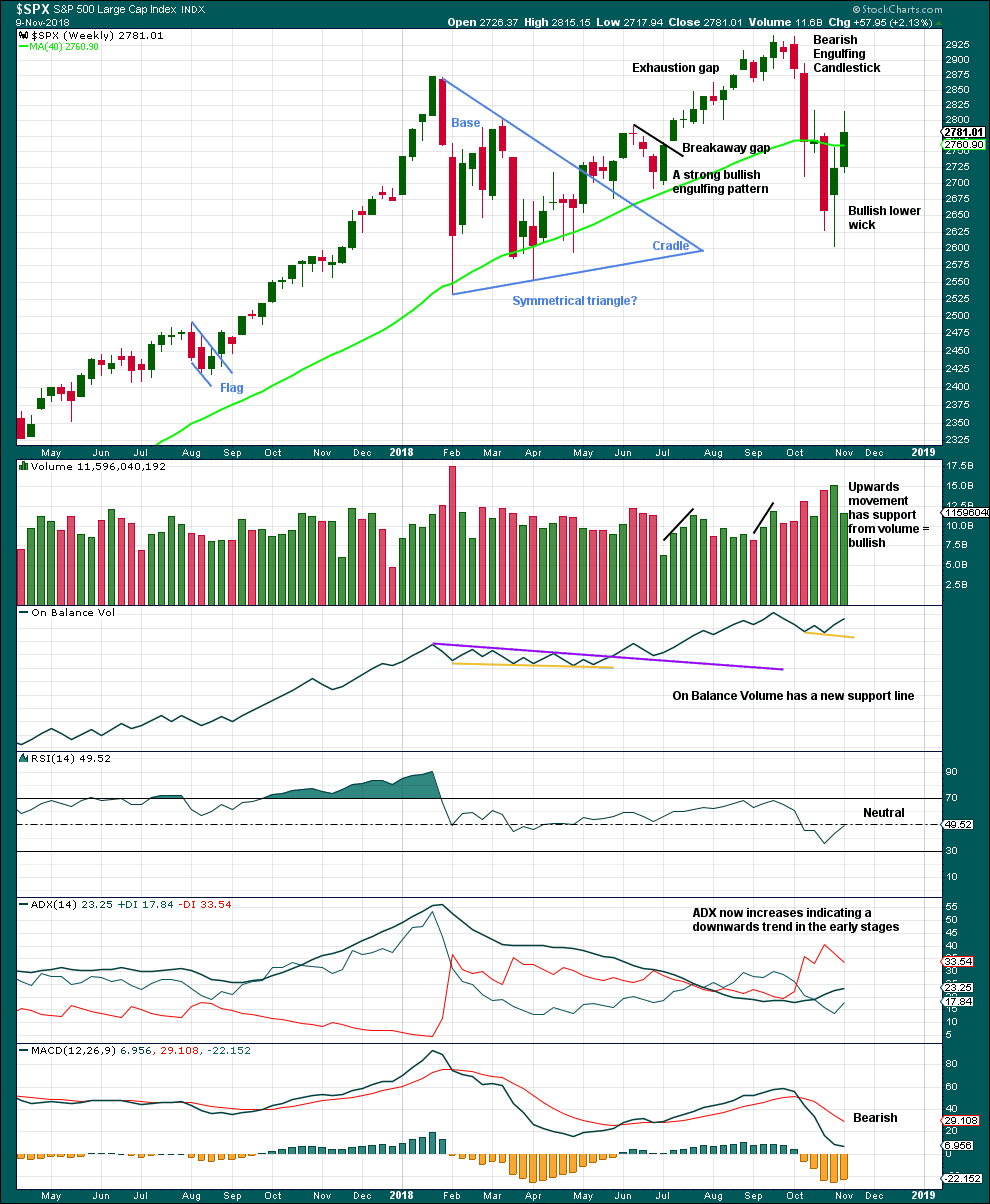
Click chart to enlarge. Chart courtesy of StockCharts.com.
Weakness in volume and a long upper wick suggest this upwards week may be a counter trend bounce. Overall, this supports the Elliott wave count.
DAILY CHART
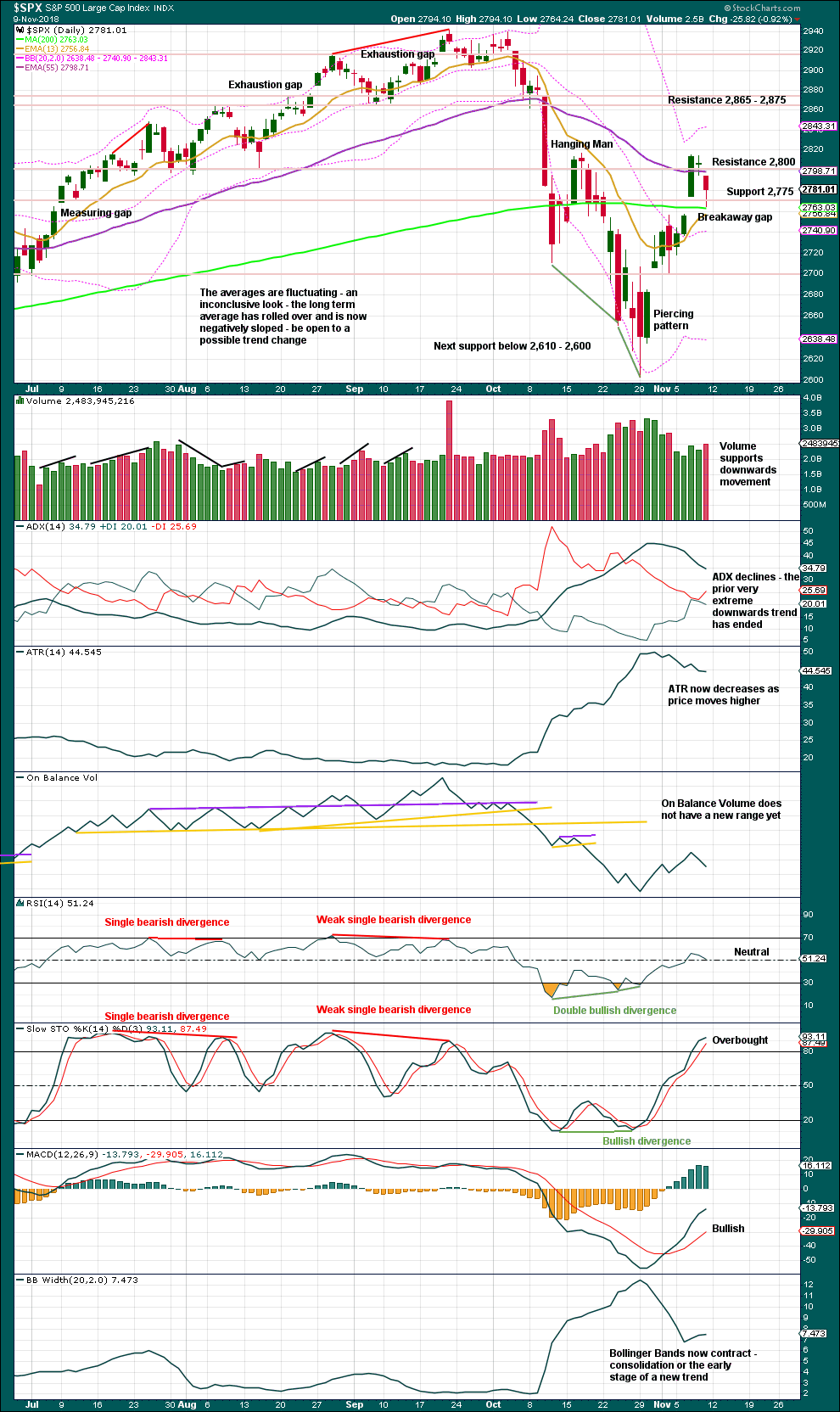
Click chart to enlarge. Chart courtesy of StockCharts.com.
The last breakaway gap remains open, and it has its lower edge at 2,756.82; Friday looks like a test of support there, which has held. The long lower wick for Friday looks bullish.
If resistance about 2,800 can again be overcome, then look for upwards movement to find next resistance about 2,865 – 2,875. This chart best supports the main Elliott wave count and the fist alternate Elliott wave count.
BREADTH – AD LINE
WEEKLY CHART
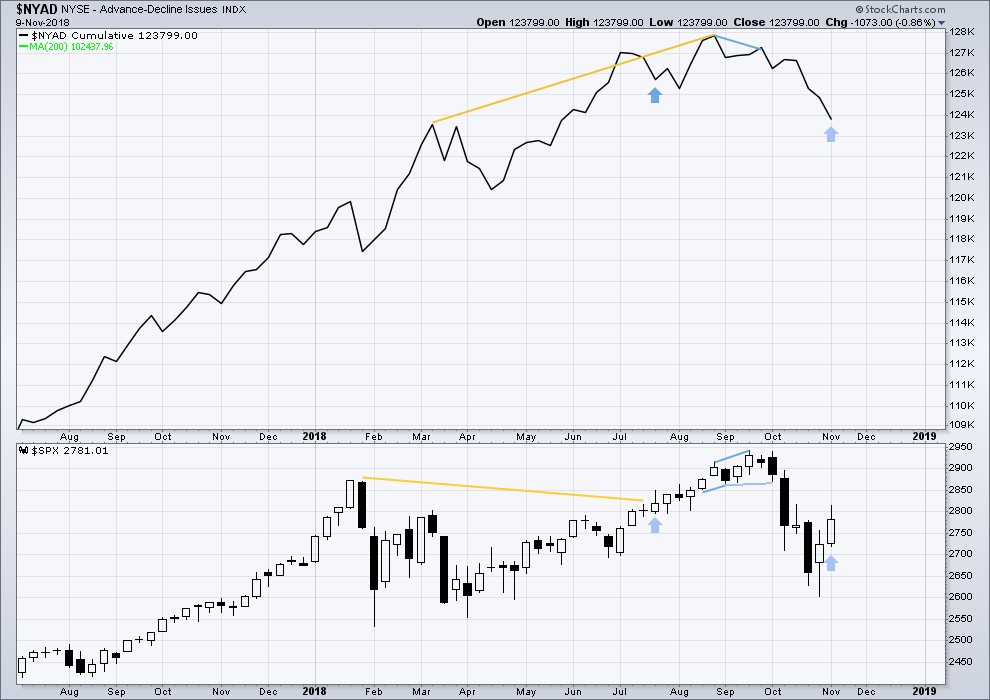
Click chart to enlarge. Chart courtesy of StockCharts.com.
This week price moved higher, but the AD line moved lower. This divergence is bearish and supports the second alternate Elliott wave count.
However, noted on this chart, there is one other instance of the same single week bearish divergence that was not followed by a downwards week.
DAILY CHART
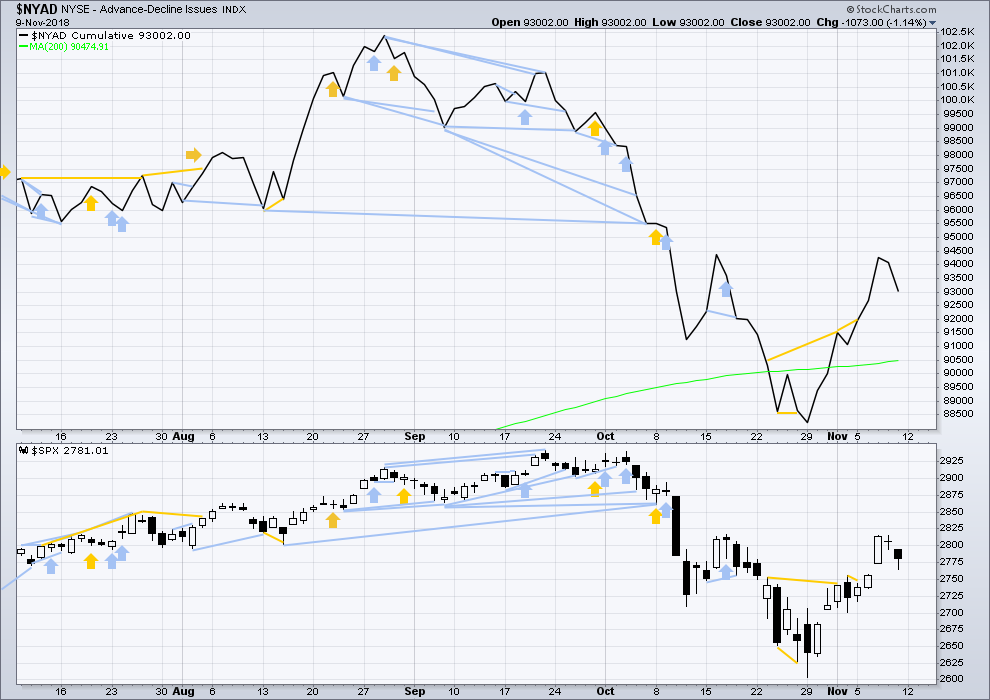
Click chart to enlarge. Chart courtesy of StockCharts.com.
There is normally 4-6 months divergence between price and market breadth prior to a full fledged bear market. This has been so for all major bear markets within the last 90 odd years. With no longer term divergence yet at this point, any decline in price should be expected to be a pullback within an ongoing bull market and not necessarily the start of a bear market. New all time highs from the AD line on the 29th of August means that the beginning of any bear market may be at the end of December 2018, but it may of course be a lot longer than that. My next expectation for the end of this bull market may now be October 2019.
Breadth should be read as a leading indicator.
Downwards movement within this last session has support from a decline in market breadth. There is no new short term divergence.
VOLATILITY – INVERTED VIX CHART
WEEKLY CHART

Click chart to enlarge. Chart courtesy of StockCharts.com. So that colour blind members are included, bearish signals
will be noted with blue and bullish signals with yellow.
This week price moved higher with inverted VIX. The rise in price this week comes with a normal corresponding decline in VIX.
DAILY CHART

Click chart to enlarge. Chart courtesy of StockCharts.com. So that colour blind members are included, bearish signals
will be noted with blue and bullish signals with yellow.
Normally, volatility should decline as price moves higher and increase as price moves lower. This means that normally inverted VIX should move in the same direction as price.
The fall in price during Friday’s session has support from a decline in inverted VIX. There is no new short term divergence.
DOW THEORY
The following lows need to be exceeded for Dow Theory to confirm the end of the bull market and a change to a bear market:
DJIA: 23,344.52.
DJT: 9,806.79.
S&P500: 2,532.69.
Nasdaq: 6,630.67.
GOLD
More downwards movement was expected as possible, but a close below support is more bearish than expected.
Summary: Friday completes a classic downwards breakout below support. Look for next support about 1,185. Have confidence in a downwards trend if price makes a new low by any amount at any time frame below 1,201.14. This week classic analysis now favours the Combination wave count.
However, it is possible that price may bounce up from here while it remains above 1,201.14. The short-term target would be at 1,247, where another multi week consolidation may begin.
Grand SuperCycle analysis is here.
Last historic analysis with monthly charts is here.
There are four remaining weekly wave counts at this time for cycle wave b: a triangle, a flat, a combination, and a double zigzag.
At this stage, they will now be presented roughly in order of probability. The triangle and the double zigzag wave counts have about an even probability; the combination and flat wave counts now look less likely.
MAIN ELLIOTT WAVE COUNT
WEEKLY CHART – TRIANGLE
Cycle wave b may be an incomplete regular contracting triangle. Primary wave E may not move beyond the end of primary wave C above 1,365.68. Within primary wave E, intermediate wave B may not move beyond the start of intermediate wave A below 1,160.75.
Four of the five sub-waves of a triangle must be zigzags, with only one sub-wave allowed to be a multiple zigzag. Wave C is the most common sub-wave to subdivide as a multiple, and this is how primary wave C for this example fits best. Primary wave E would most likely be a single zigzag. It is also possible that it may subdivide as a triangle to create a rare nine wave triangle.
There are no problems in terms of subdivisions or rare structures for this wave count. It has an excellent fit and so far a typical look.
Primary wave E may now continue higher as a large three wave structure.
DAILY CHART – TRIANGLE
Primary wave E should now be underway for this wave count.
Primary wave E should subdivide as a zigzag. Intermediate wave (A) should subdivide as a five wave structure.
Within intermediate wave (A), so far minor waves 1 through to 3 may now be complete. Minor wave 3 exhibits no Fibonacci ratio to minor wave 1. Minor wave 2 was a relatively shallow 0.497 flat correction.
Minor wave 4 may now be a completed and relatively deep 0.55 flat correction. There is some alternation in depth with minor wave 2 but no alternation in structure.
Minor wave 4 may have ended about support at the lower edge of the Elliott channel.
Minor wave 4 may not move into minor wave 1 price territory below 1,201.14.
Minor wave 2 lasted 27 sessions. Minor wave 4 may have ended in a Fibonacci 13 sessions. This gives reasonable proportion to minor wave 2.
Draw the channel about intermediate wave (A) using Elliott’s first technique. Draw the first trend line from the ends of minor waves 1 to 3, then place a parallel copy on the end of minor wave 2.
A target is calculated for minor wave 5, which expects it to exhibit the most common ratio to minor wave 1.
A target for primary wave E is the strong zone of resistance about 1,305 to 1,310. Primary wave E is most likely to subdivide as a zigzag (although it may also subdivide as a triangle to create a rare nine wave triangle), and it should last at least a Fibonacci 13 weeks. It may also last a total Fibonacci 21 or 34 weeks. So far it has lasted only 11 weeks. Primary wave E may not move beyond the end of primary wave C above 1,365.68.
WEEKLY CHART – DOUBLE ZIGZAG
It is also possible that cycle wave b may be a double zigzag or a double combination.
The first zigzag in the double is labelled primary wave W. This has a good fit.
The double may be joined by a corrective structure in the opposite direction, a triangle labelled primary wave X. The triangle would be about three quarters complete.
Within the triangle of primary wave X, intermediate wave (C) should be complete. Within intermediate wave (D), minor wave B may not move beyond the start of minor wave A below 1,160.75.
Intermediate wave (D) would most likely subdivide as a single zigzag. The subdivisions at the daily chart level for this wave count would be the same as for the first triangle wave count above; a zigzag unfolding higher would be labelled A-B-C.
This wave count may now expect choppy overlapping movement in an ever decreasing range for several more months.
Primary wave Y would most likely be a zigzag because primary wave X would be shallow; double zigzags normally have relatively shallow X waves.
Primary wave Y may also be a flat correction if cycle wave b is a double combination, but combinations normally have deep X waves. This would be less likely.
This wave count has good proportions and no problems in terms of subdivisions.
WEEKLY CHART – COMBINATION
If cycle wave b is a combination, then the first structure in a double may be a complete zigzag labelled primary wave W.
The double may be joined by a three in the opposite direction, a zigzag labelled primary wave X.
The second structure in the double may be a flat correction labelled primary wave Y. My research on Gold so far has found that the most common two structures in a double combination are one zigzag and one flat correction. I have found only one instance where a triangle unfolded for wave Y. The most likely structure for wave Y would be a flat correction by a very wide margin, so that is what this wave count shall expect.
Within a flat correction for primary wave Y, the current downwards wave of intermediate wave (B) may be a double zigzag. Intermediate wave (B) must retrace a minimum 0.9 length of intermediate wave (A) at 1,147.34. Intermediate wave (B) may move beyond the start of intermediate wave (A) as in an expanded flat.
Because the minimum requirement for intermediate wave (B) is not yet met, this wave count requires that intermediate wave (B) continues lower. This is the most immediately bearish of all four weekly wave counts.
When intermediate wave (B) is complete, then intermediate wave (C) would be expected to make at least a slight new high above the end of intermediate wave (A) at 1,365.68 to avoid a truncation. Primary wave Y would be most likely to end about the same level as primary wave W at 1,374.91, so that the whole structure takes up time and moves price sideways, as that is the purpose of double combinations.
While double combinations are very common, triples are extremely rare. I have found no examples of triple combinations for Gold at daily chart time frames or higher back to 1976. When the second structure in a double is complete, then it is extremely likely (almost certain) that the whole correction is over.
DAILY CHART – COMBINATION
Minor wave X may again be complete.
Minor wave Y may be underway for this wave count to continue lower to a minimum at 1,147.34. Minor wave Y may last a few weeks.
This wave count requires a new low below 1,201.14 for confidence. If that happens on Monday, then expect a downwards trend to continue to at least 1,147.34.
WEEKLY CHART – FLAT
It is possible that cycle wave b may be a flat correction. Within a flat correction, primary wave B must retrace a minimum 0.9 length of primary wave A at 1,079.13 or below. Primary wave B may make a new low below the start of primary wave A at 1,046.27 as in an expanded flat correction.
Only a new low reasonably below 1,123.08 would provide reasonable confidence in this wave count.
Intermediate wave (C) must subdivide as a five wave structure; it may be unfolding as an impulse. Within intermediate wave (C), minor waves 1 through to 4 may be complete. If it continues further, then minor wave 4 may not move into minor wave 1 price territory above 1,307.09.
The blue channel is drawn using Elliott’s second technique. Minor wave 5 may end at support about the lower edge of this channel.
Minor wave 2 was a double zigzag lasting nine weeks. Minor wave 4 exhibits little alternation as a single zigzag and reasonable proportion lasting ten weeks.
TECHNICAL ANALYSIS
WEEKLY CHART
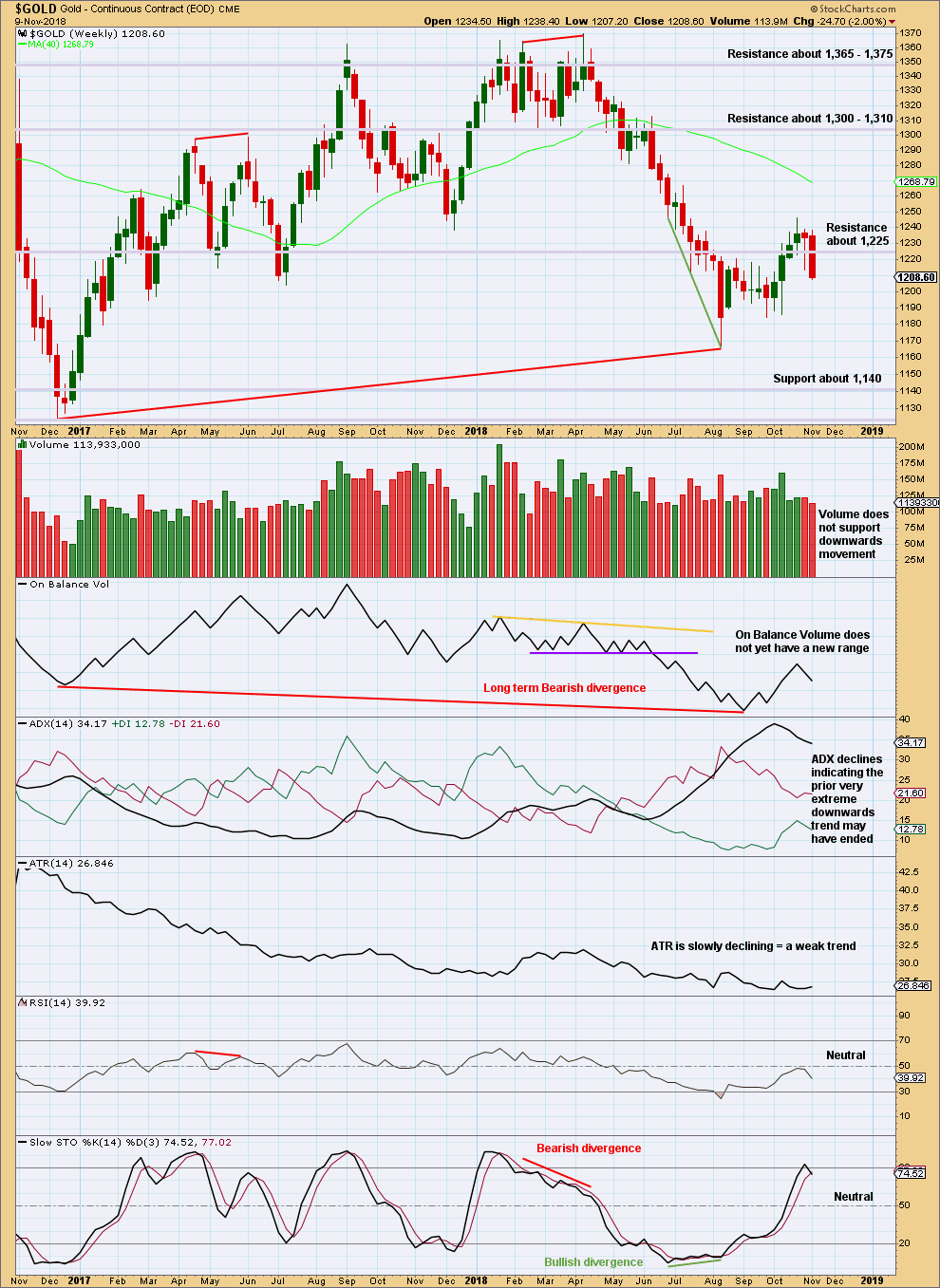
Click chart to enlarge. Chart courtesy of StockCharts.com.
On Balance Volume has made a lower low than its prior low at the end of November 2015. This divergence is extremely bearish but does not rule out a consolidation unfolding here; the divergence does strongly support the Triangle wave count, which expects a consolidation or bounce up to test resistance now and then a continuation of a major bear market. It could also support the flat wave count that allows for a new low below 1,046.27 in coming months.
The Hanging Man reversal pattern of last week now has bearish confirmation. This week completes a strong Bearish Engulfing candlestick pattern.
It looks like the bounce may be over. This weekly chart supports the Combination Elliott wave count.
DAILY CHART
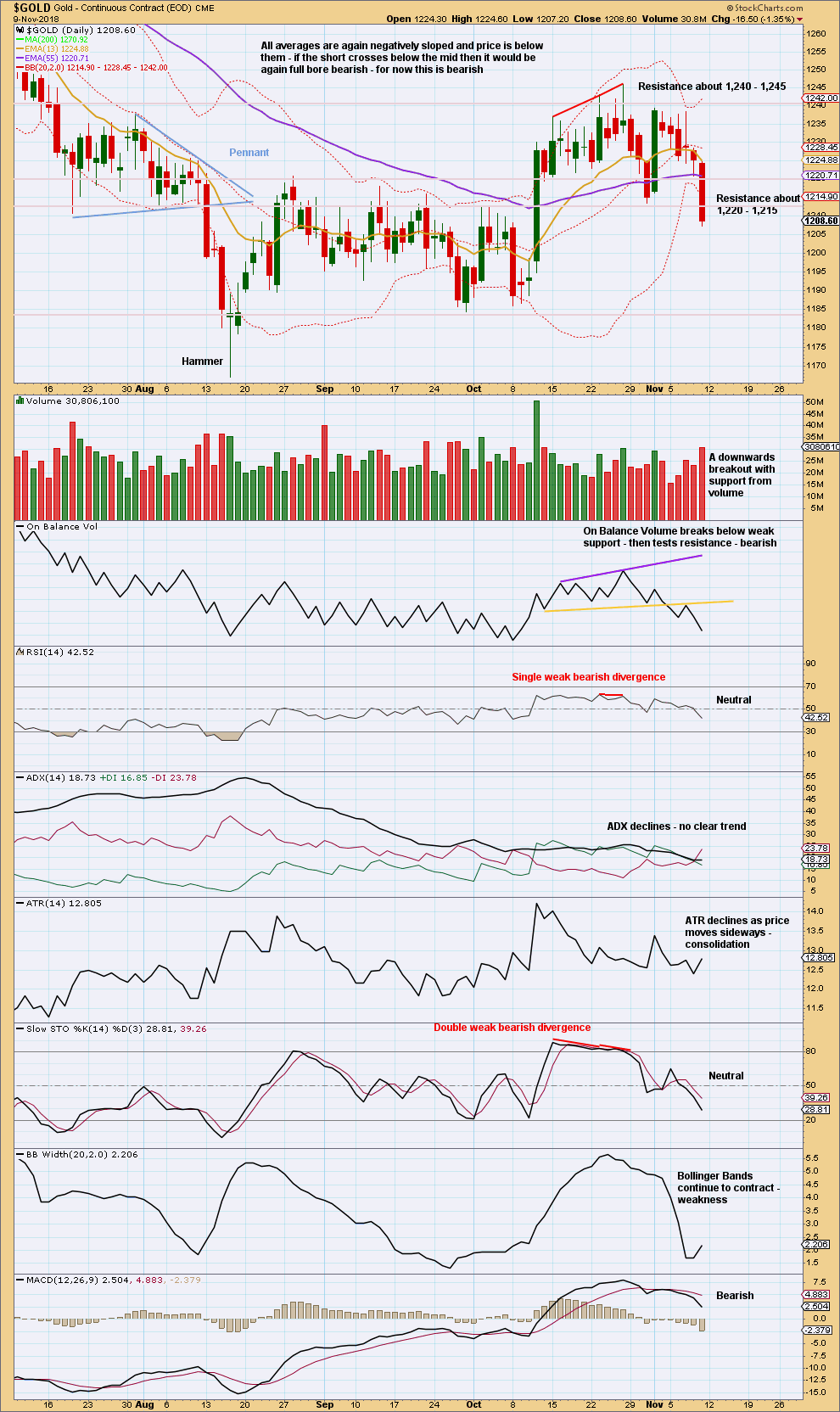
Click chart to enlarge. Chart courtesy of StockCharts.com.
Price has closed below support, which was at 1,215, on a downwards day that has support from volume. Downwards breakouts do not require support from volume for confidence, but when volume does support them increased confidence may be had.
RSI and Stochastics indicate there is room for price to fall further. Look for next support about 1,185.
This chart also supports the Combination Elliott wave count.
GDX WEEKLY CHART

Click chart to enlarge. Chart courtesy of StockCharts.com.
GDX had a large consolidation that lasted from January 2017 to August 2018. A downwards breakout below support at 20.80 in early August 2018 is highly significant. The breakout had support from volume, which adds confidence.
Upwards movement to the high now looks like a completed back test of resistance close to prior support at 20.80. The Evening doji star pattern indicates the bounce may be complete. The high last week at 20.51 is exactly the upper edge of the breakaway gap.
It would now be typical to see price move down and away. The target is at 16.02.
GDX DAILY CHART
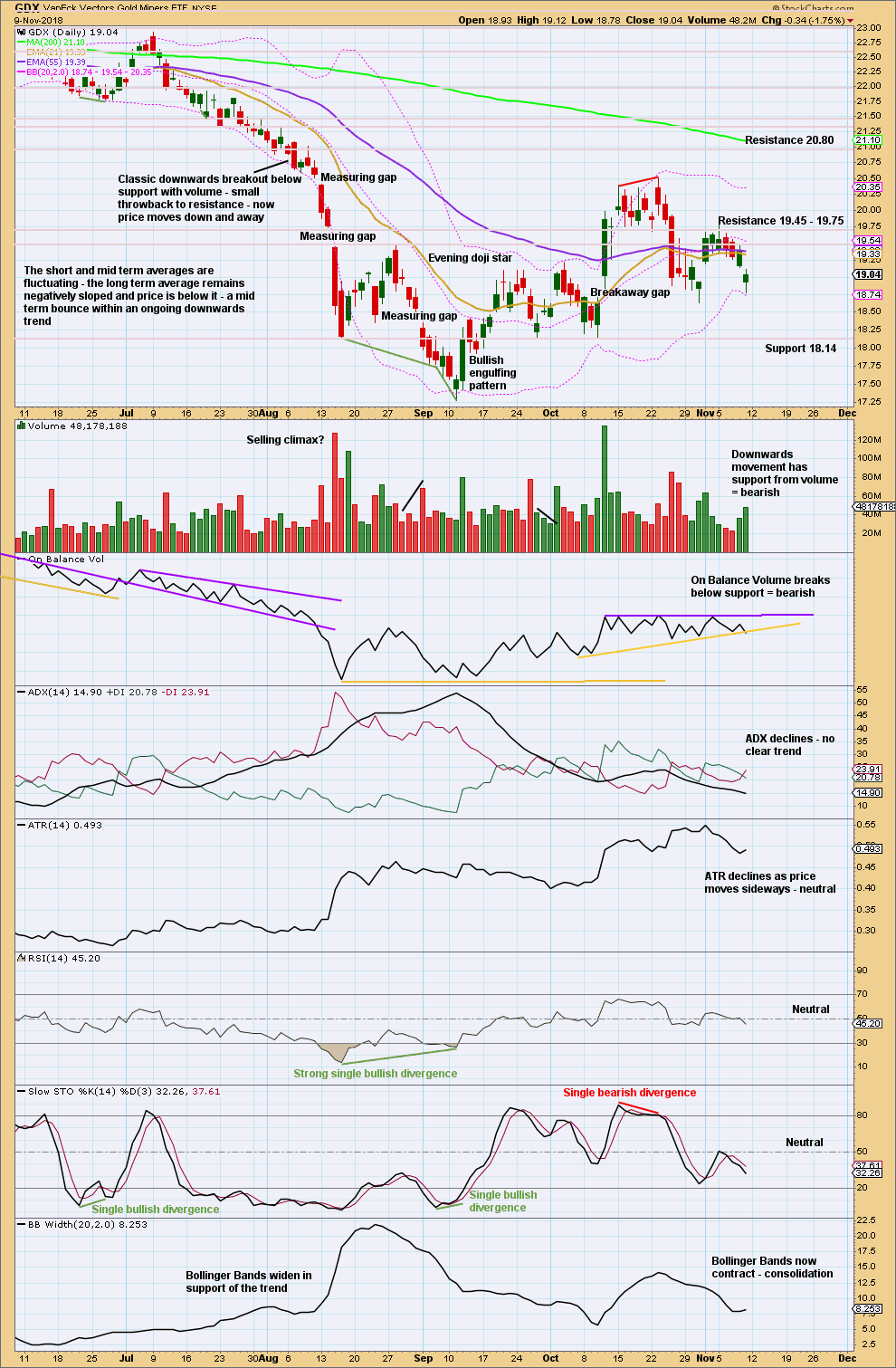
Click chart to enlarge. Chart courtesy of StockCharts.com.
Consider the bounce back up towards resistance at 20.80 now most likely complete.
US OIL
Price has remained within the small channel all week, so no indication that a low could be in place has been given.
Summary: At this stage, the classic technical analysis no longer supports the Elliott wave count. While it is still possible that the Elliott wave count could be correct, indicators are very bearish; there is a clear downwards trend here for Oil.
Assume the trend remains the same until proven otherwise.
While price remains within the narrow channel on the daily chart, assume price will continue to fall. A fall below 55.24 would be very bearish indeed.
For confidence in the Elliott wave count the channel needs to be breached. A bullish candlestick reversal pattern would add further confidence. Finally, price moving back above the Fibonacci 55 day moving average would add reasonable confidence.
Oil will be watched closely next week. Check in with the comments section to see any updates if anything changes.
ELLIOTT WAVE COUNT
MONTHLY CHART
The bear market for US Oil looks to be over and a new bull market looks to be in its early stages. The prior bearish wave count has been invalidated, leaving only this very bullish wave count.
A huge zigzag down to the last low may be complete and is labelled here Super Cycle wave (II).
Cycle wave b must be seen as complete in August 2013 for this wave count to work. It cannot be seen as complete at the prior major swing high in May 2011.
Cycle wave b is seen as a zigzag, and within it primary wave B is seen as a running contracting triangle. These are fairly common structures, although nine wave triangles are uncommon. All subdivisions fit.
Primary wave C moves beyond the end of primary wave A, so it avoids a truncation. But it does not have to move above the price territory of primary wave B to avoid a truncation, which is an important distinction.
If cycle wave b begins there, then cycle wave c may be seen as a complete five wave impulse.
Super Cycle wave (III) must move beyond the end of Super Cycle wave (I). It must move far enough above that point to allow room for a subsequent Super Cycle wave (IV) to unfold and remain above Super Cycle wave (I) price territory.
Cycle wave I may be incomplete. It may be unfolding as an impulse and may have now moved through the middle portion. Commodities have a tendency to exhibit swift strong fifth waves, and this tendency is especially prevalent for third wave impulses. Intermediate wave (5) to end primary wave 3 may be very swift and strong, ending with a blow off top.
At this stage, at the monthly chart level, the current pullback labelled intermediate wave (4) now has good proportion to intermediate wave (2). This part of the wave count has the right look at this time frame; it looks like an incomplete impulse for primary wave 3.
When cycle wave I is complete, then cycle wave II may be a deep correction that may not move beyond the start of cycle wave I below 26.06.
Data from FXCM for USOil does not go back to the beginning of Super Cycle wave (I). Without an accurate known length of Super Cycle wave (I) a target cannot be calculated for Super Cycle wave (III) to end using Fibonacci ratios. The target for Super Cycle wave (III) may be calculated when cycle waves I, II, III and IV within it are complete. That cannot be done for many years.
WEEKLY CHART
Intermediate wave (3) is now complete. There is no Fibonacci ratio between intermediate waves (1) and (3), and intermediate wave (3) is longer than 1.618 the length of intermediate wave (1).
This wave count fits with classic technical analysis at the monthly and daily chart levels.
Intermediate wave (2) was a deep double zigzag.
Intermediate wave (4) is this week relabelled as a complete expanded flat correction. Downwards movement this week is too deep for a normal looking combination (combinations are sideways movements), and this now has the normal look of wave C of an expanded flat. Expanded flats are common structures.
There would now be perfect alternation between the double zigzag of intermediate wave (2) and an expanded flat of intermediate wave (4).
The channel about primary wave 3 on this weekly chart, which is on a semi-log scale, is drawn using Elliott’s first technique. Drawn on this scale, there is still some room here for price to fall further. If price keeps falling, then look for strong support now at the lower edge of the channel.
If price falls further, then the target zones would need to be recalculated.
Intermediate wave (4) may not move into intermediate wave (1) price territory below 55.24.
I have tried to see a more bearish Elliott wave count for US Oil. At this time, I have not been able to find a good solution. That does not mean one does not exist. If I find it, it will be published in comments this week.
DAILY CHART
Intermediate wave (4) may be now be a complete or almost complete expanded flat correction. Minor wave B is just a little longer than the most common range of up to 1.38 times the length of minor wave A, but well within the maximum conventional allowance of up to 2 times the length of minor wave A.
There is no adequate Fibonacci ratio between minor waves A and C.
Price remains within the narrow best-fit channel. A breach of this channel is required for confidence that a low is in place. The breach should be by a full green daily candlestick above and not touching the upper edge of the channel.
If a candlestick reversal pattern appears at the low, that would also offer confidence that a low is in place.
It must be accepted that price may continue to fall while it remains within the downwards best-fit channel.
On this daily chart, which is on an arithmetic scale, the lower edge of the black Elliott channel is now overshot.
TECHNICAL ANALYSIS
MONTHLY CHART
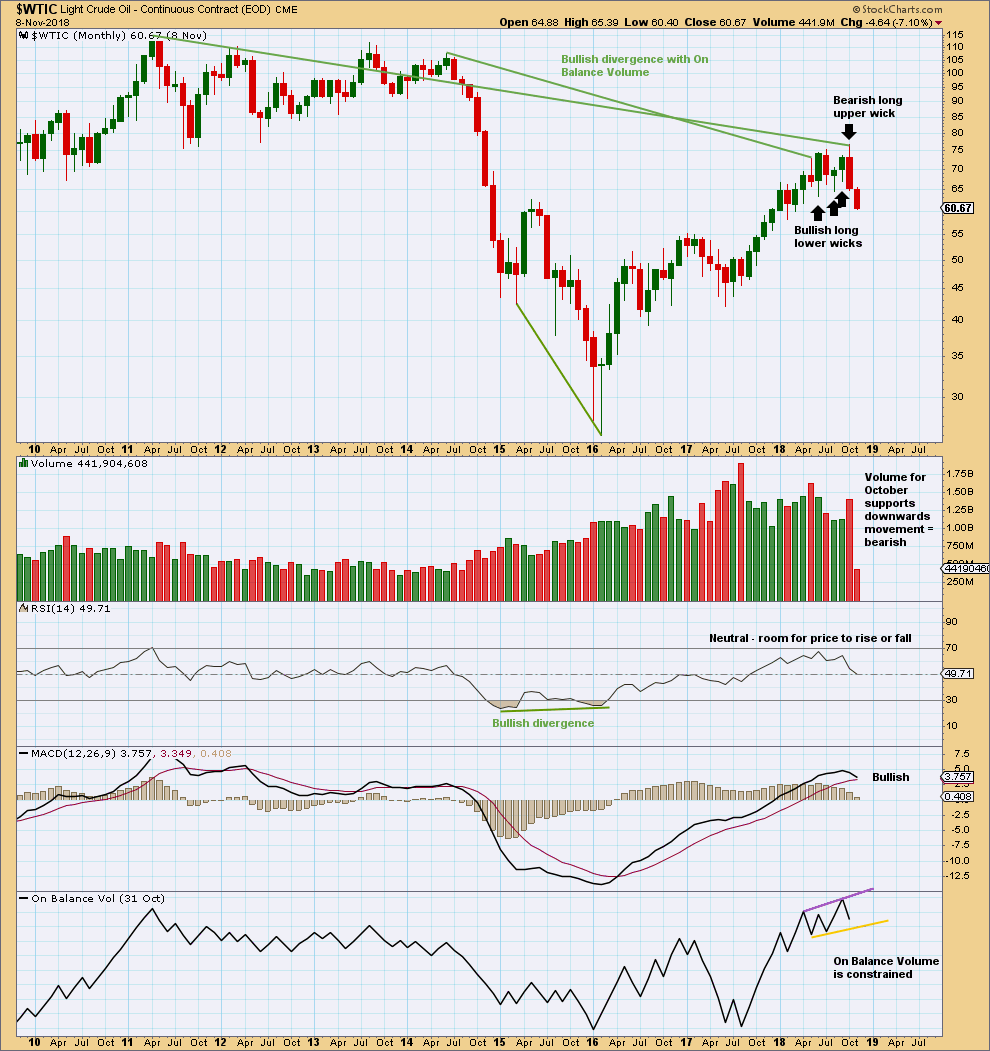
Click chart to enlarge. Chart courtesy of StockCharts.com.
The larger trend remains upwards.
With a long upper candlestick wick and support from volume, the last completed month of October is bearish. On its own, this is not an indication of the end of the upwards trend though; it is noted that August 2017 was similar yet price continued higher.
However, the month of October also completes a Bearish Engulfing candlestick pattern. This is a strong reversal pattern. This offers a warning that the Elliott wave count may be wrong. Members are advised to carefully manage risk if expecting price may continue upwards from here.
Bullish divergence between price and On Balance Volume remains, and is still a strong technical indicator that price may continue upwards to make new highs.
WEEKLY CHART
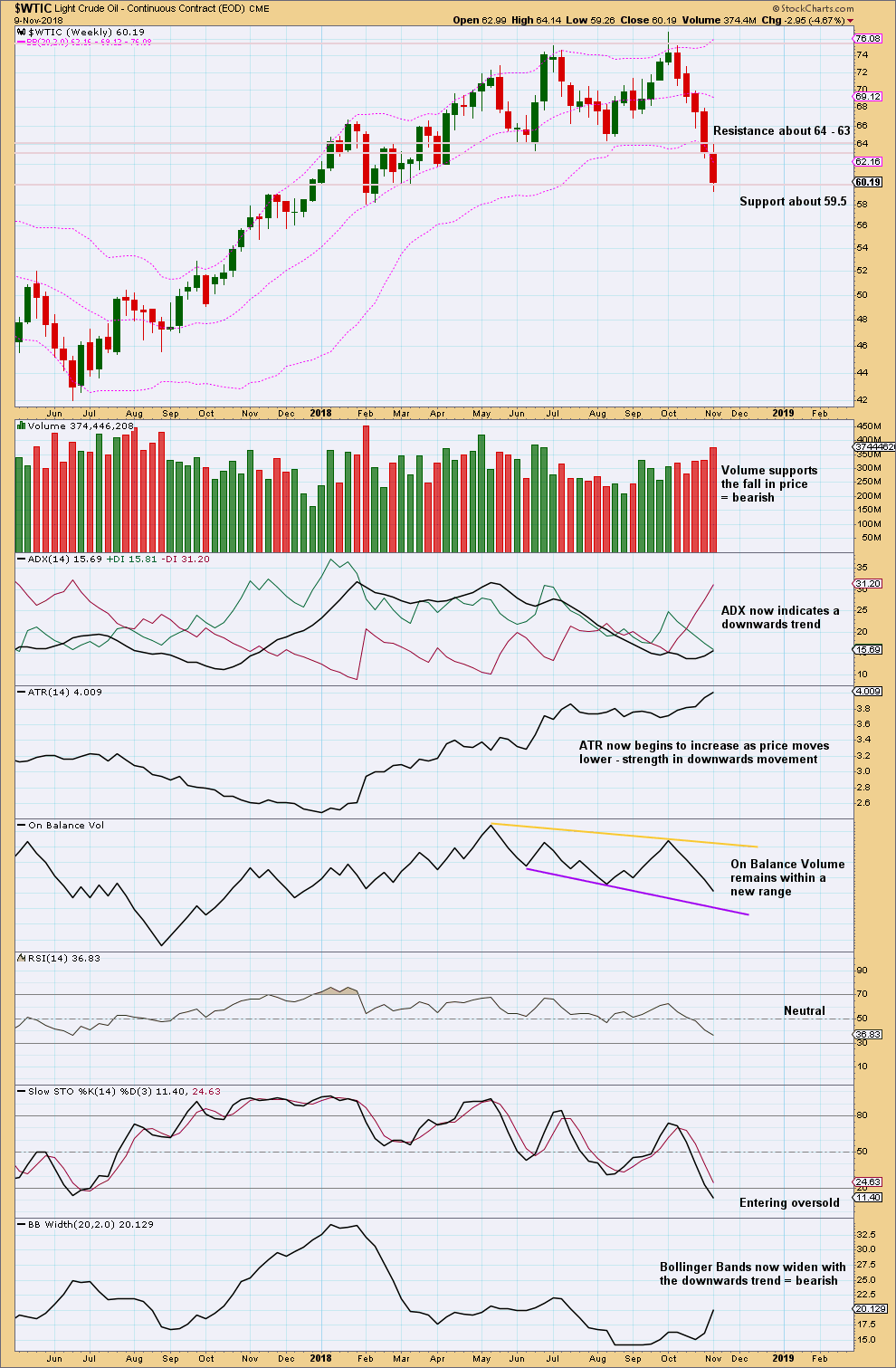
Click chart to enlarge. Chart courtesy of StockCharts.com.
While this week may be seen as a downwards breakout from a consolidation, which had support about 63, price is still in a strong cluster of support here.
It does look at this stage like a new downwards trend may be in its early stages.
Indicators at the weekly chart time frame are not yet extreme. There is plenty of room for price to fall here. Expect this current downwards trend to continue until there is a candlestick reversal pattern.
DAILY CHART
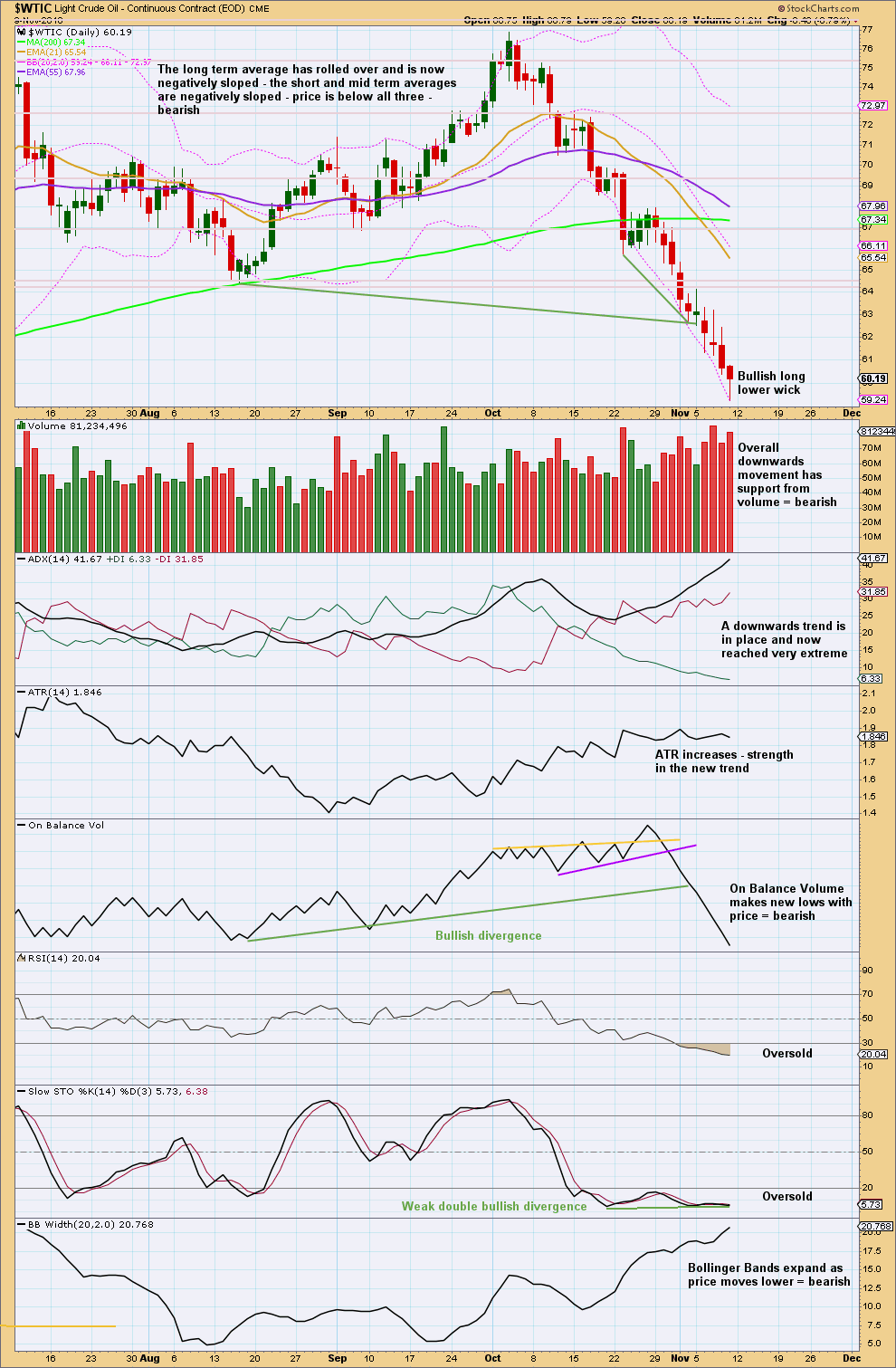
Click chart to enlarge. Chart courtesy of StockCharts.com.
I have taken some time today to look back at the last strong bearish trend from Oil from about May 2014 to January 2016. I have noticed that downwards waves often end with support from volume, and sometimes do not even end with a long lower wick. Bullish reversal patterns are often but not always found at lows. RSI can reach very extreme and remain so for as long as three months when this market has a strong downwards trend. At lows Stochastics often will exhibit bullish divergence, but this can be rather weak. At lows RSI sometimes, not always, exhibits bullish divergence and can remain deeply oversold for long periods of time.
US Oil is a particularly difficult market to find lows in. It can trend strongly for very long periods of time with indicators remaining very extreme.
At this time, there is now clearly a downwards trend in place. This could continue for months yet. While price remains within the channel on the daily Elliott wave chart, expect it to continue to fall.
Expect that a low has been found only if a bullish candlestick reversal pattern appears, or the channel is clearly breached. But note that even if these occur, that any bounce may still be short lived. Only if the Fibonacci 55 day moving average is breached and price returns above it may we then have reasonable confidence in the Elliott wave count.
—
Always practice good risk management as the most important aspect of trading. Always trade with stops and invest only 1-5% of equity on any one trade. Failure to manage risk is the most common mistake new traders make.

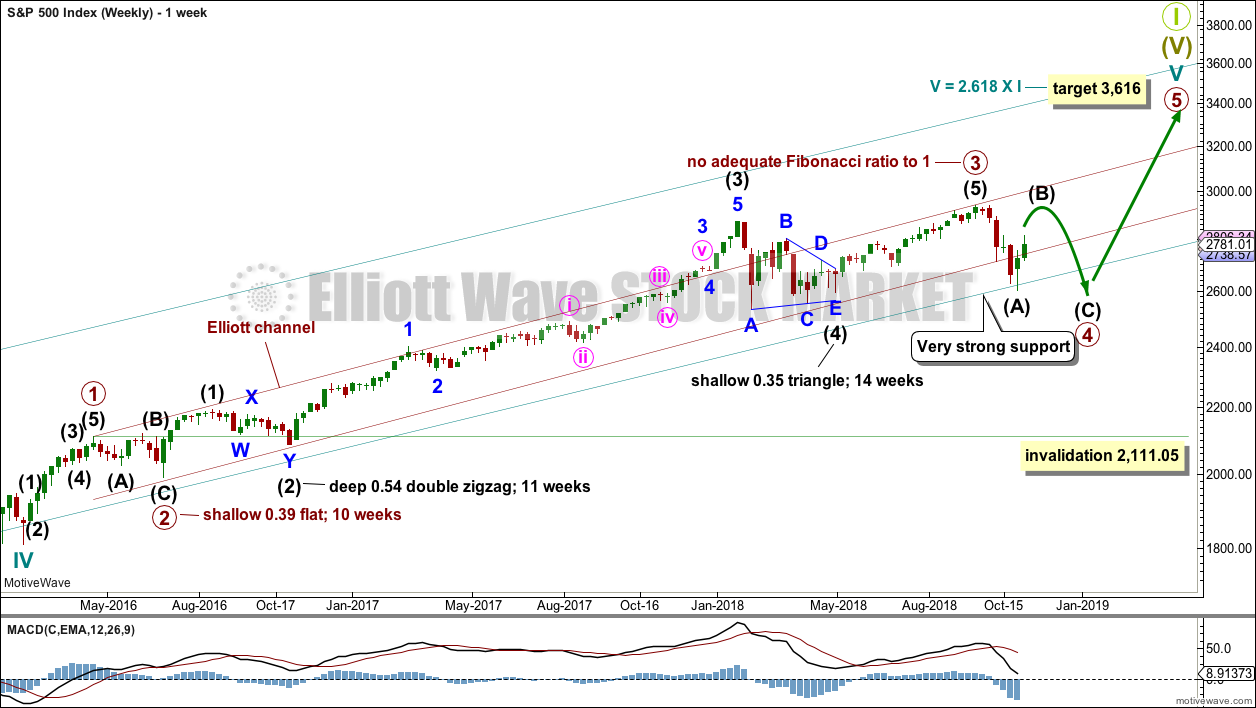
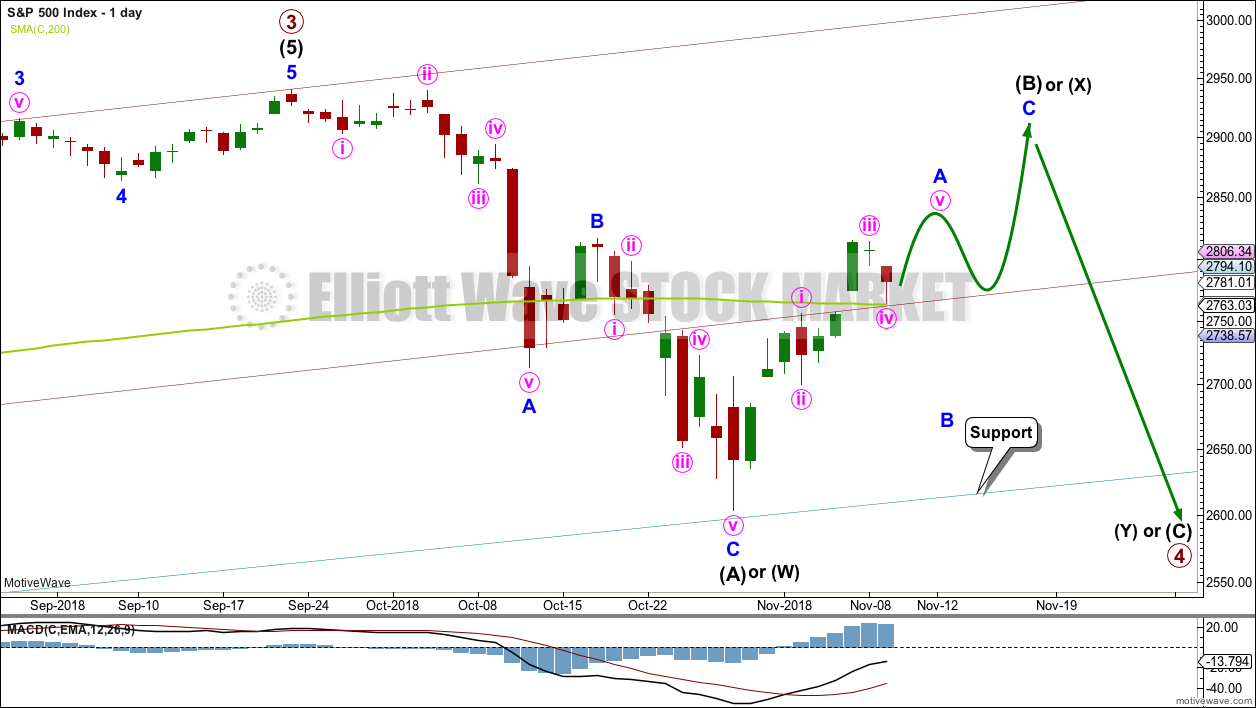

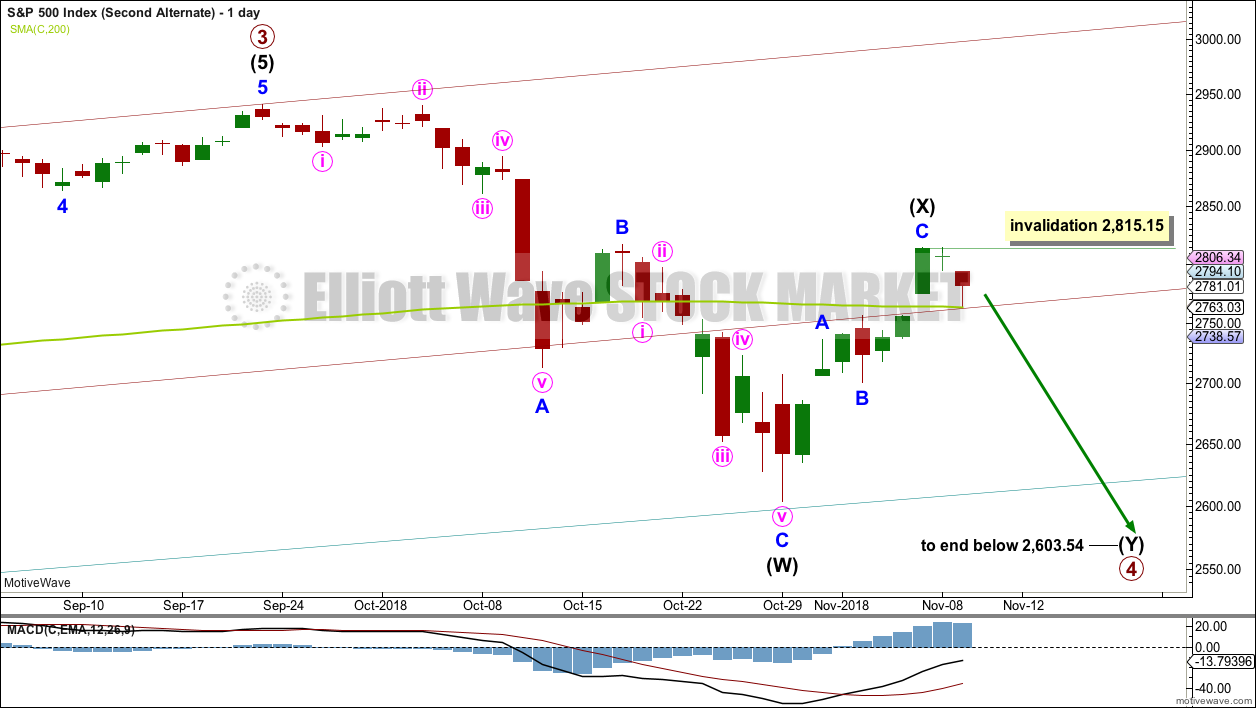
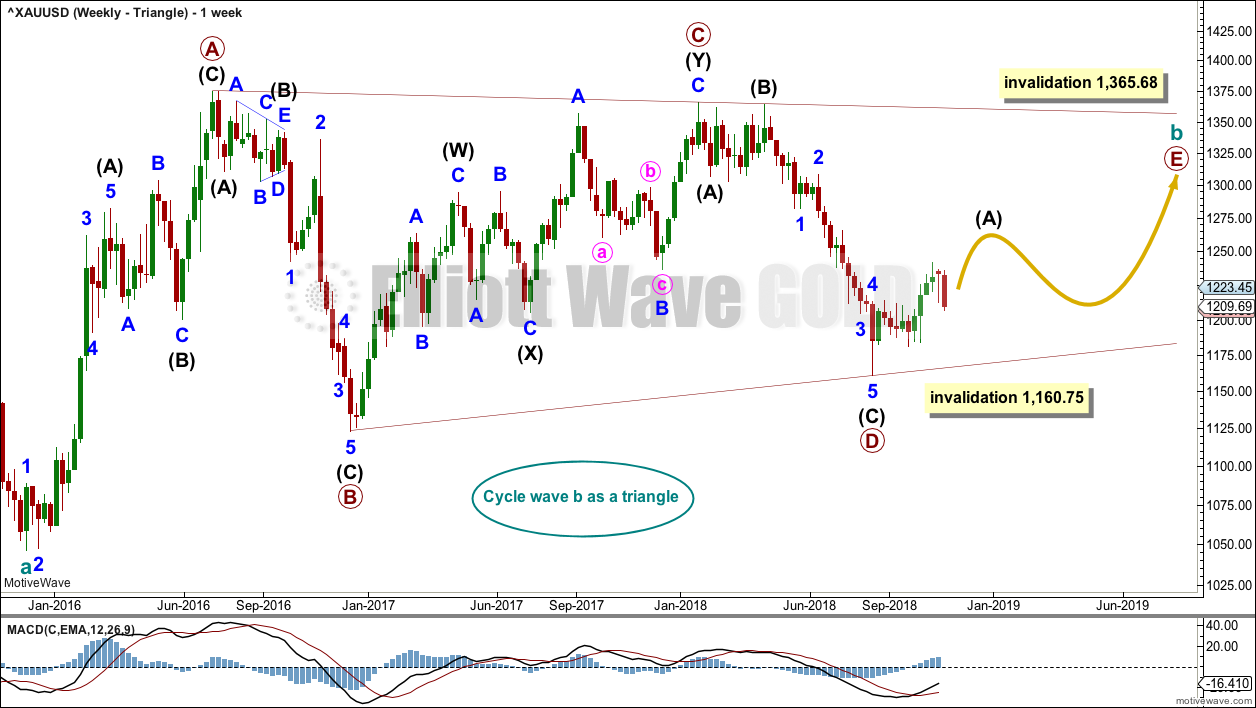
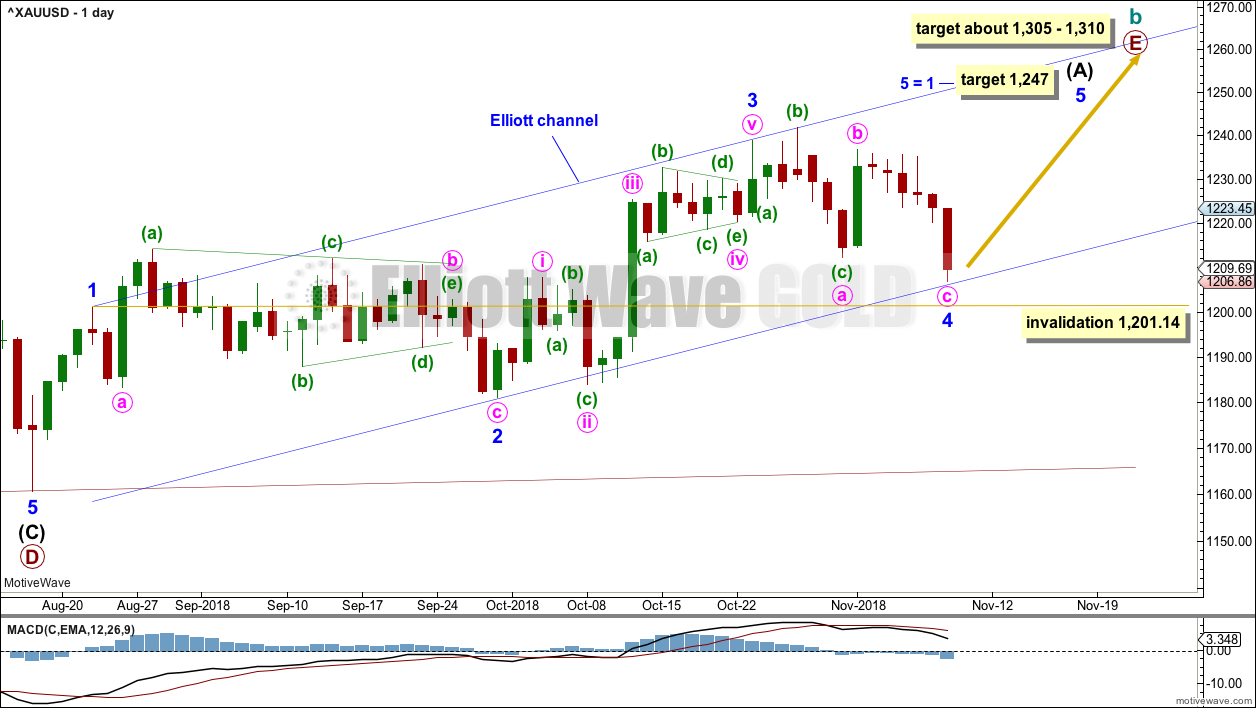

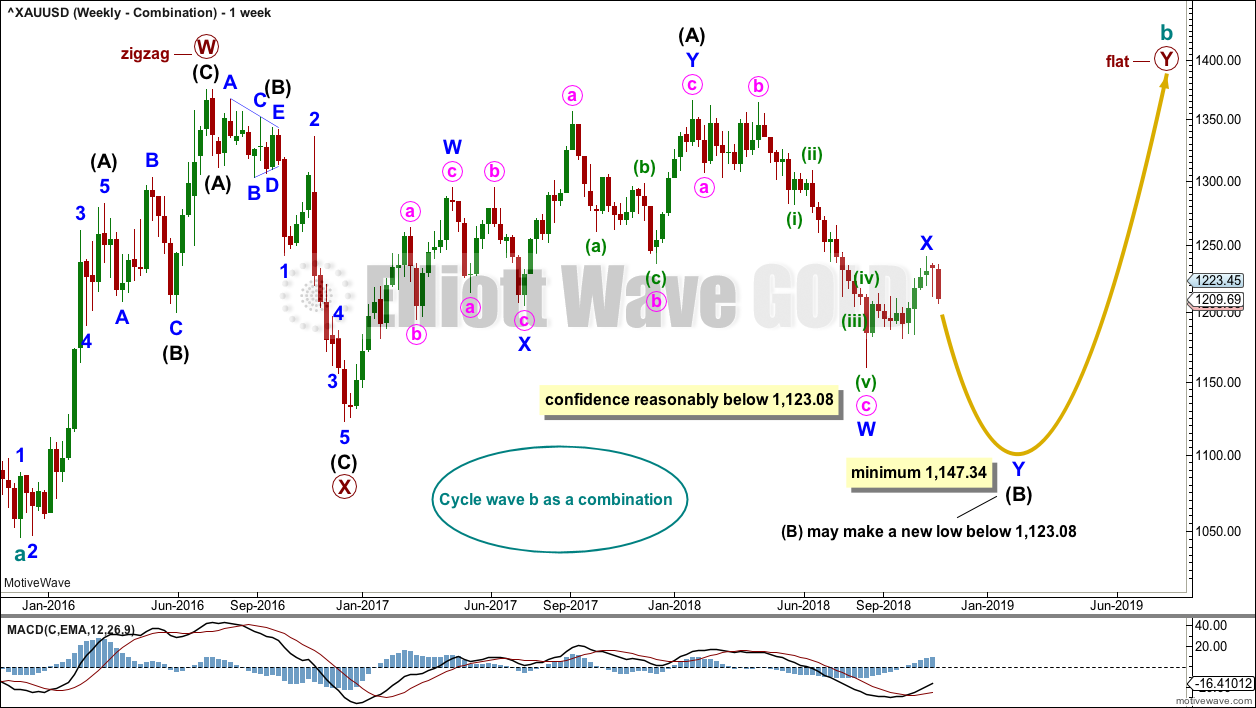
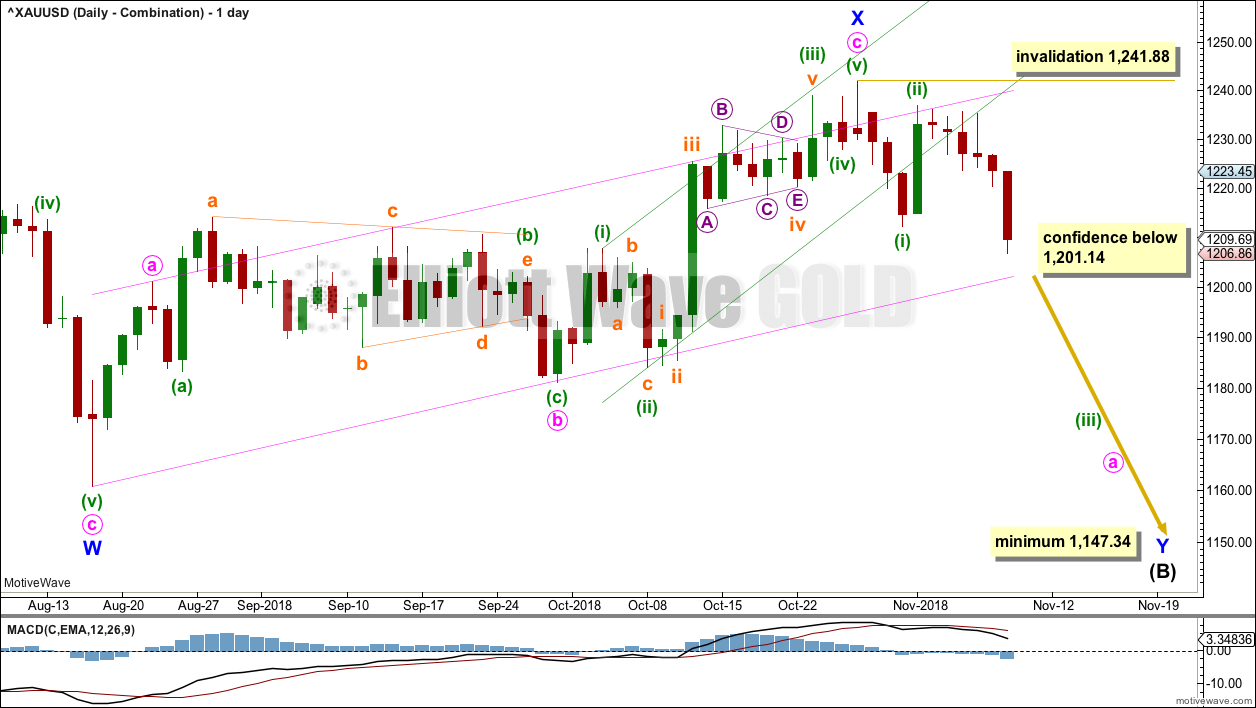
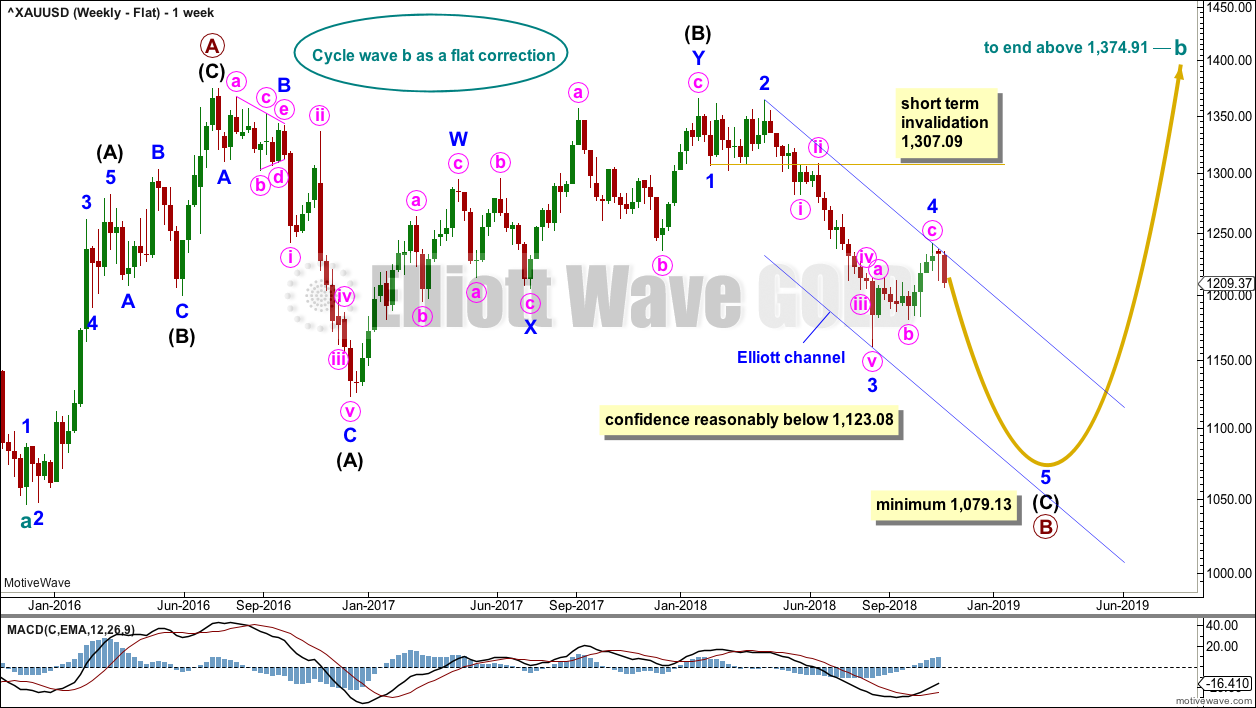
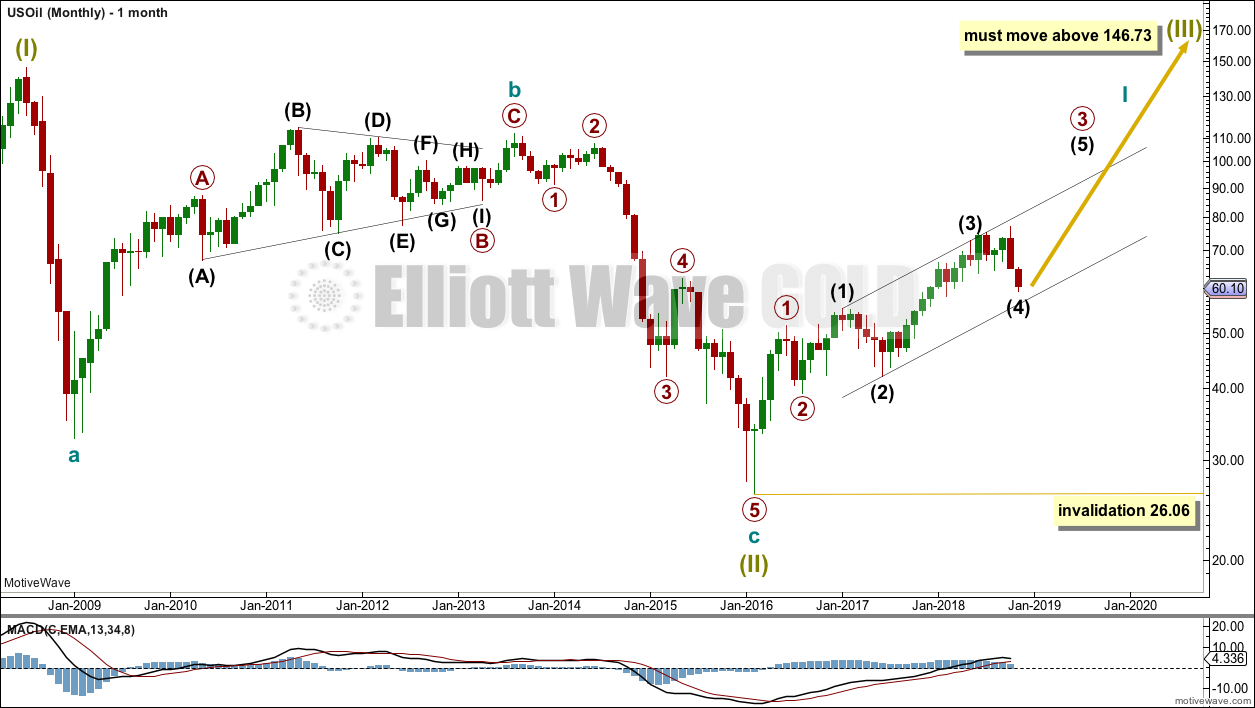


US Oil analysis is updated and will be published very shortly. As a new, separate, intra week analysis.
If members could leave any comments for the rest of the week regarding Oil on the new Oil analysis, that’d be great. Thanks.
I have two EW ideas for Oil. I’ll be updating charts later today.
Your questions will be answered in those charts.
For now, the classic analysis remains the same. And Oil can continue with strength for months yet in a downwards trend. The trend is down. Only short positions should be held.
If anyone was holding a long position it should have been automatically closed for a managed loss when the EW count was invalidated.
Because all positions should have stops.
Hi Laura, I show your 55.24 level was broken today so I would assume the recent high was a Wave 4 corrective structure and now we are looking at a potential for a nasty 5th wave lower into a new lower low. Your thoughts?
Invalidation level of 55.24 means that the current bullish Elliott wave count is wrong…. Lara is probably working hard to find another count…. Oil chart looks very weak unfortunately.
I am interesting to see what Lara will introduce as another count…. I am sure it will be very bearish.
Hi Laura, On Oil it is hard to find any wave structure for this drop at all as it has been almost straight down. Is this possibly just Wave A of an ABC lower or even more bearish, still wave 1 of 5 down? Seems like the next bounce should be shorted. What are your thoughts here?
Hi Lara,
Everything is getting messy across all the markets but what do you think if wave down in gold is not over and it will end somewhere right above 1125? Like on the charts I attached? It seems that wave IV is not over too🤷🏼♂️🤷🏼♂️ After that V down you can apply all other alternatives but double-combination up looks the most probable☝️ 🤷🏼♂️ Triangle is doubtful as gold can not even go to 1260🤷🏼♂️🤷🏼♂️🤷🏼♂️ Any thoughts on such wave count??? Look at your latest USD chart along with this gold wave count…..if it tops at 101-102 the gold should not go lower than 1125☝️☝️☝️ Look where gold was when USD was at 103,7☝️1122☝️🤷🏼♂️ Why should it go lower if USD tops below 103,7 as it is on your latest chart?? No way…. if USD goes higher than 103,7 – all the bets are off….welcome to hell😩😱 so, the USD becomes the key for everything and when and where it tops will matter a lot for all the risk assets and commodities incl gold and oil☝️🤷🏼♂️
You’re still assuming a relationship between gold and USD index. It just does not exist. That’s not my opinion, that’s math.
And so I must answer your questions about what I think Gold should do based upon what the USD Index is doing with…. I don’t. The math shows these two markets do not have a reliable correlation. And so the math is indicating that what one market does does not necessarily influence what the other one does.
I also note that for some people this statement I make here is controversial. And that despite what the math shows plenty of people will still insist the two markets simply must be related.
That’s fine, but please be aware that I’m going to rely upon the math. I do hope this helps you in knowing what my answers may be to your questions, before you ask them.
Finally, yes, if Gold price makes it down as low as 1,125 then the combination wave count would look highly likely. The flat wave count would too actually.